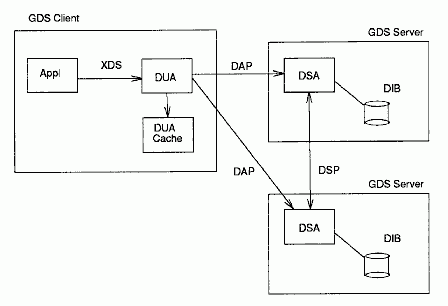
The DUA cache is a process that keeps a cache of information obtained from DSAs. One DUA cache runs on each client machine and is used by all users on that client. The DUA cache contains copies of recently accessed object entries and information about DSAs. The user specifies which information should be cached. It is also possible to bypass the DUA Cache to obtain information directly from a DSA. This is desirable, for example, when the user wants to make sure the information obtained is up-to-date.
The shadow update and cache update are processes that update replicated information in DSAs and DUA caches. These processes run as needed and then terminate. The shadow update process runs on the GDS server machine; the cache update process runs on GDS client machines.
When an application program makes a directory service call by using XDS API, the call is handed to the DUA library. The DUA first looks in the DUA cache (if requested by the user) to see if the requested information is already available on the local machine. If it is not, the DUA queries a DSA. If the DSA has the requested information, it returns the results to the DUA. If it does not, the query can proceed either by using chaining or a referral. In either case, different DSAs are queried until the information is found. It is cached (if requested by the user) in the DUA cache and the results are returned to the application program.
The following figure shows the interaction between an application program, via the XDS interface, and the GDS client and server. The GDS client and server use DAP to communicate. GDS servers use the DSP to communicate with one another. DAP and DSP perform functions similar to the functions that DCE RPC protocols perform in other DCE services.
GDS Components

More:
Placing Entries in the Local DUA Cache
Accessing the DUA Cache Without a GDS Server Present